Apple Tree Pests: Complete Guide with Photos
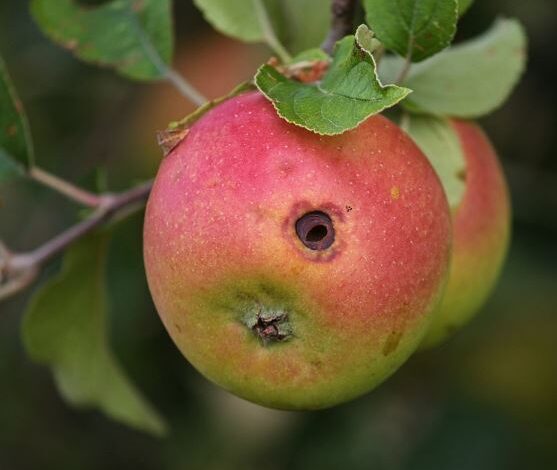
Hello to all gardeners! In today’s article we are going to see which are the most important pests of the apple tree . We will learn to identify them one by one in a simple way to be able to eliminate them as soon as possible. First of all, if we must highlight some of them, they would be: apple carpocapsa, aphids or mites.
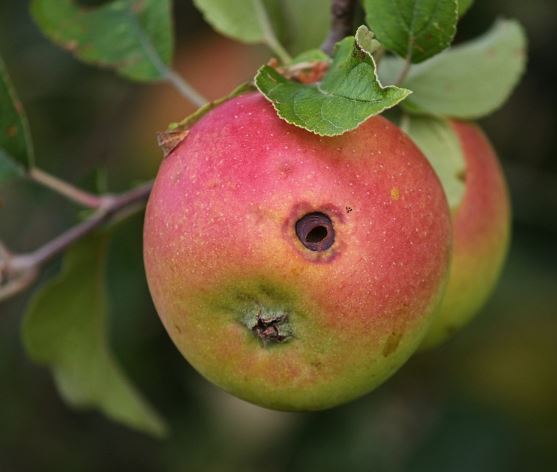
Aphids: green, white and black aphids
As we already know, aphids are one of the most common pests that we can find in any vegetable garden or garden. Year after year they are there. The important thing is to know how to identify them (because there are many different species) to eliminate them as soon as possible.
In the case of the apple tree, the aphid species that most affect it are: the green apple aphid ( Aphis pomi ), the ashy aphid ( Dysaphis plantaginea ) and the woolly aphid ( Eriosoma laniferum ). Let’s see them one by one!
Green apple aphid
The green apple aphid or Aphis pomi , spends its entire life cycle on the apple tree. It produces the curl of the leaves of the apple tree when chopping them and feeding on the sap. Indirectly, it can affect the photosynthesis of plants and reduce their performance.
We can distinguish it from the rest of the apple tree aphids thanks to its green color and its black siphons (the two 2 «sticks» at the end of its body).
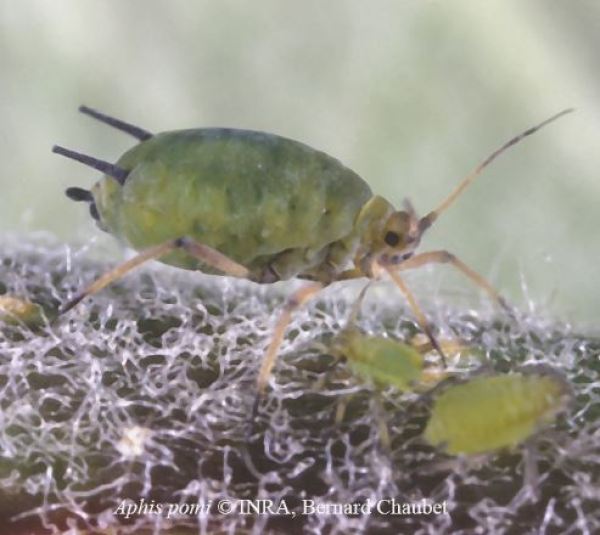
White aphid or woolly apple aphid
The woolly aphid or Eriosoma lanigerum is very characteristic in apple trees . We must be careful and not confuse it with the cottony mealybugs since their appearance is similar. They are covered by a kind of white cotton (waxy secretions) but the color of their body is dark.
This species can affect the roots, trunks and branches of the apple tree. Sometimes they form galls due to reactions of the plant against the toxic saliva of aphids when biting.
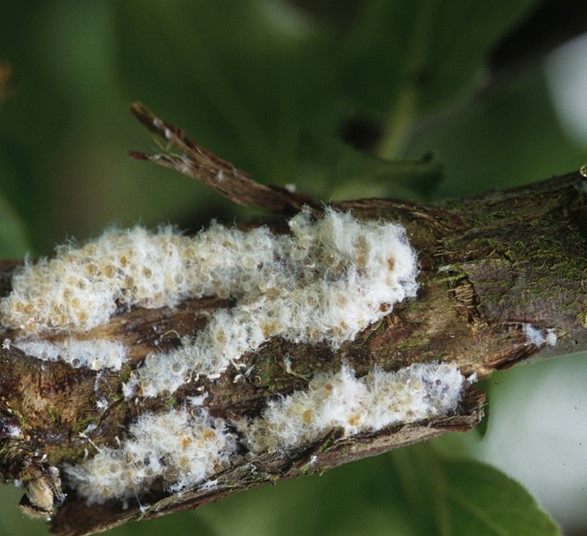
Black aphid or ashy aphid
The ashy aphid , scientifically known as
Dysaphis plantaginea , is the most harmful aphid for apple trees . If the attack of this species is important it can cause the deformation and depreciation of the fruits.
Another characteristic symptom of this species is the appearance of rolled, yellow leaves.
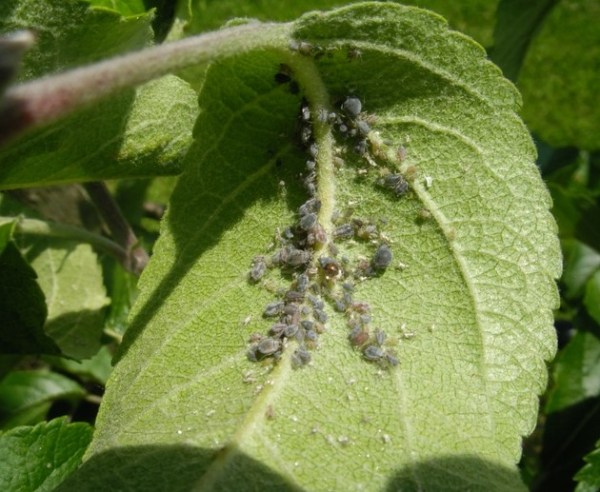
To control apple aphids in your orchards here is this link where we explain it step by step: » Control aphids in the orchard step by step «.
Carpocapsa del manzano: caterpillars on the apple tree
Without a doubt, one of the most important pests of the apple tree is the apple tree carpocapsa . Scientifically it is known by the name of Cyda pomonella . It is a lepidopteran of the family of the tortrícidos. It attacks several fruit trees apart from the apple tree such as pear trees or plums.
The adult is gray-brown with coppery stripes. The larvae are golden with black heads. There are normally 2 generations a year. Winters as a caterpillar in trunk grooves and tree branches. The caterpillars, as soon as the fruits come out, dig galleries inside. If conditions are favorable they pupate and later become adults.
The optimal conditions for the mating of this insect are sunsets, a temperature greater than 15ºC and a relative humidity greater than 60%. During the day, the adults are immobile in the trees.
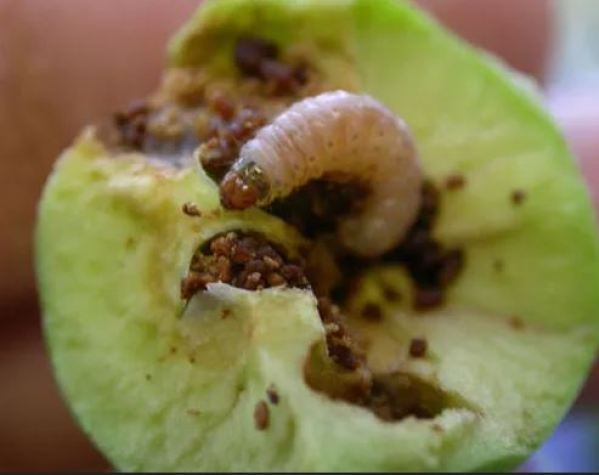
Control of apple carpocapsa
The main control methods are based on:
- Bait banding
- Withdrawal of attacked fruits
- Flight tracking
- Egg surveillance
- Sexual confusion
- Some predators of these species are birds of the genus Picus or bats
Mediterranean fruit fly
The Mediterranean fruit fly is known in the scientific world as Ceratitis capitata . This fly from Africa is present throughout the Mediterranean area.
It can affect various fruits other than apples. Among them: peach, apricot, orange, mandarin, figs, grapes, pomegranates, medlars, plums, pears, custard apples, papayas, mangoes, etc.
Once the fruits are infected, the larvae develop inside . The infected fruit falls prematurely and the one picked from the tree immediately rots. The larvae pupate and pass the puparium stage in the soil .
Here you have a photo of the fly in adult state:
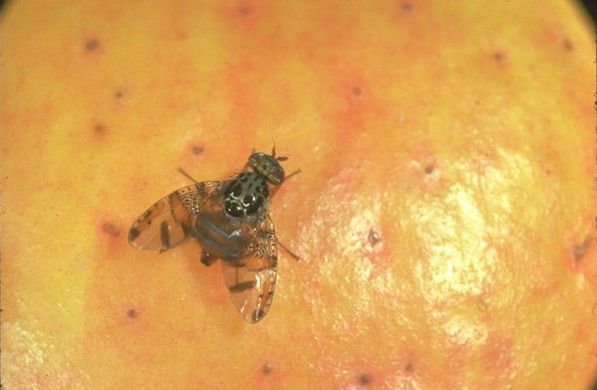
Here you have an article where we focus on this pest: « Fruit fly in the orchard «.
Mites on the apple tree
Mites are also everywhere so the apple trees are not going to be spared. The red mite or Panonychus ulmi is the most present in the apple tree.
They are characterized by discoloring the leaves of the tree and sometimes small spider webs appear on the leaves. Also if we are good observers we can see their egg laying, as shown in the following image:
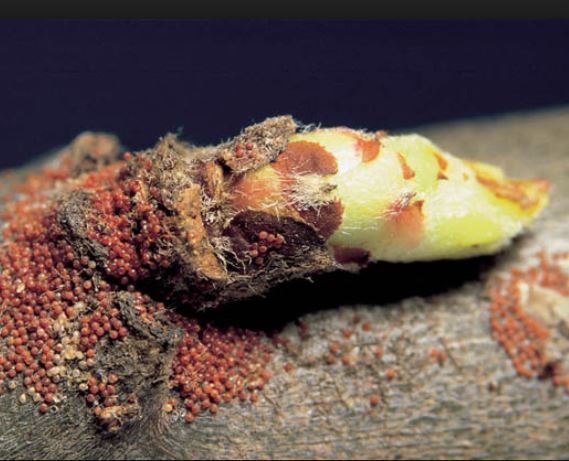
Bark beetles or bark beetles
If you approach your apple trees and see small holes in the bark … BAD, BAD, BAD! It is surely a type of beetle of the curculionidae family known as the borer. Its scientific name is Scolytus rugulosus .
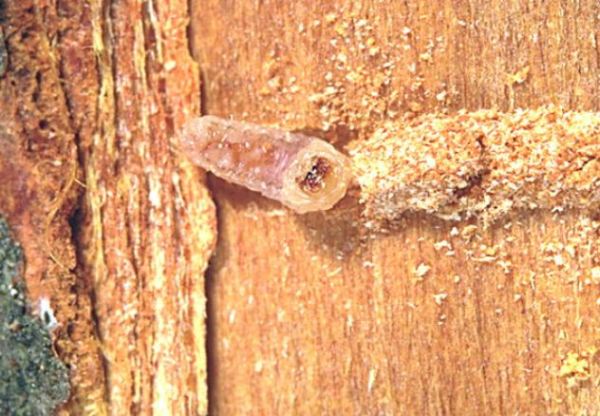
These types of insects are tiny and shiny black. They love to make galleries in the wood of our apple trees like the ones we see in this photo:
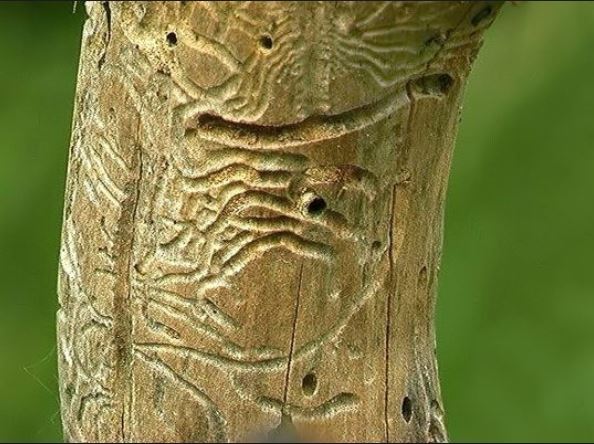
Normally they take advantage of existing lesions in the tree to enter and start making these galleries. In my case, we did construction works in the town and the occasional blow they hit the poor apple tree … Months later I discovered that the entire trunk was full of holes caused by this insect.
Other pests of the apple tree
We have already seen the most important pests that can affect our apple trees. Finally, I leave you a small list of other pests of the apple tree that we can find on some other occasion:
- Anthonomus pomorum
- Zeuzera pyrina
- Mealybugs ( Lepidosaphes ulmi, Epidiaspis leperii )
- Quadraspidiotus perniciosus

![Photo of Thymus Mastichina: [Cultivation, Associations, Pests and Diseases]](https://www.complete-gardening.com/wp-content/uploads/2022/08/thymus-mastichina-cultivation-associations-pests-and-diseases-390x220.png)
![Photo of Vine Treatment: [Pruning and Sulfur Application]](https://www.complete-gardening.com/wp-content/uploads/2022/08/vine-treatment-pruning-and-sulfur-application-390x220.png)
![Photo of White Nettle: [Benefits, Effects, Preparation and Cure]](https://www.complete-gardening.com/wp-content/uploads/2022/08/white-nettle-benefits-effects-preparation-and-cure-390x220.jpg)
![Photo of Yellow Poppy: [Cultivation, Irrigation, Care, Pests and Diseases]](https://www.complete-gardening.com/wp-content/uploads/2022/08/yellow-poppy-cultivation-irrigation-care-pests-and-diseases-390x220.jpg)